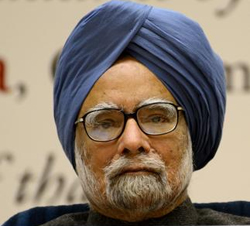
New Delhi, Aug 30: Prime Minister Manmohan Singh on Friday ruled out reversal of reforms or resorting to capital controls to rescue the sliding rupee, which he said fell on account of domestic as well as global factors.
Making a statement on the state of the economy in Parliament amid concerns over rapid depreciation of rupee, Singh said the country has to be ready for short-term shocks but the government will ensure that the fundamentals of economy remain strong.
"We are faced with challenges but we have the capacity to deal with them,", he said, while seeking support of all political parties in this situation.
Breaking his silence on the decline of rupee, he said there "may be short term shocks to our economy and we need to face them. That is the reality of the globalised economy, whose benefits we have reaped".
There is no question of reversing the policies just because there is some turbulence in capital and currency markets, he said, adding the "sudden decline in exchange rate is certainly a shock, but we will address this through other measures, not through capital controls or by reversing reforms".
Not satisfied with the Prime Minister's statement, the Opposition parties including BJP, AIADMK, Left and SAD later staged a walk-out in the Lok Sabha.
Pitching for more reforms, the Prime Minister said easy reforms of the past have been done but the difficult ones remain.
"We have the more difficult reforms to do such as reduction of subsidies, insurance and pension sector reforms, eliminating bureaucratic red tape and implementing Goods and Services Tax," he said.
"These are not low hanging fruit and need political consensus... We need to forge consensus on such vital issues. I urge political parties to work towards this end and to join in the government's efforts to put the economy back on the path of stable and sustainable growth," Singh said.
The Prime Minister attributed the sudden and sharp depreciation in rupee to various domestic and global factors like high current account deficit (CAD), US Federal Reserve plans to taper quantitative easing measures and tensions in Syria.
"... the rupee has been especially hit because of our large CAD and some other domestic factors. We intend to act to reduce the CAD and improve the economy," Singh said.
The deterioration in CAD, he said, has been mainly on account of huge import of gold, higher cost of crude oil imports and recently of coal.
Moreover, Singh said that exports have been further hit by collapse in iron ore shipments making "our CAD unsustainably large".
"Clearly we need to reduce our appetite for gold, economisz the use of petroleum products and take steps to increase our exports," the Prime Minister said, adding the government will take all possible steps to bring down CAD below USD 70 billion this fiscal.
The Prime Minister said the medium term objective of the government will be to reduce CAD to 2.5 per cent of GDP and the government will make all efforts to maintain "a macro economic framework friendly to foreign capital inflows to enable orderly financing of the current account deficit".
"... it is important to recognise that the fundamentals of the Indian economy continue to be strong," Singh said.
Emphasising that the country's overall public-debt to GDP ratio has been declining, he said India's external debt is only 21.2 per cent of GDP while short-term stands at 5.2 per cent.
"Our forex reserves stand at USD 278 billion, and are more than sufficient to meet India's external financing requirements," he said.
The rupee depreciation, he said, can be good for economy as it will help to increase the export competitiveness and discourage imports.
The foreign exchange markets, he regretted, have a notorious history of overshooting.
"Unfortunately, this is what is happening not only in relation to the rupee but also other currencies," Singh said, stressing that the value of a currency is determined by fundamental of the economy and the government is taking steps to improve them.
Referring to economic prospects, Singh said that even though growth has slowed down in recent quarters, it is expected to pick up.
"I expect growth in the first quarter of 2013-14 to be relatively flat, but as the effects of the good monsoon kick in, I expect it to pick up," he said.
"All in all, the macro-stabilisation process which should support the value of the rupee is under way. I expect that as the fruits of our efforts materialise, currency markets will recover," he said.
Regarding fiscal deficit, the Prime Minister said the government will do whatever is necessary to contain the fiscal deficit to be 4.8 per cent this year.
"The most growth friendly way to contain the deficit is to spend carefully, especially on subsidies that do not reach the poor, and we will take effective steps to that end," he said.





Comments
Add new comment